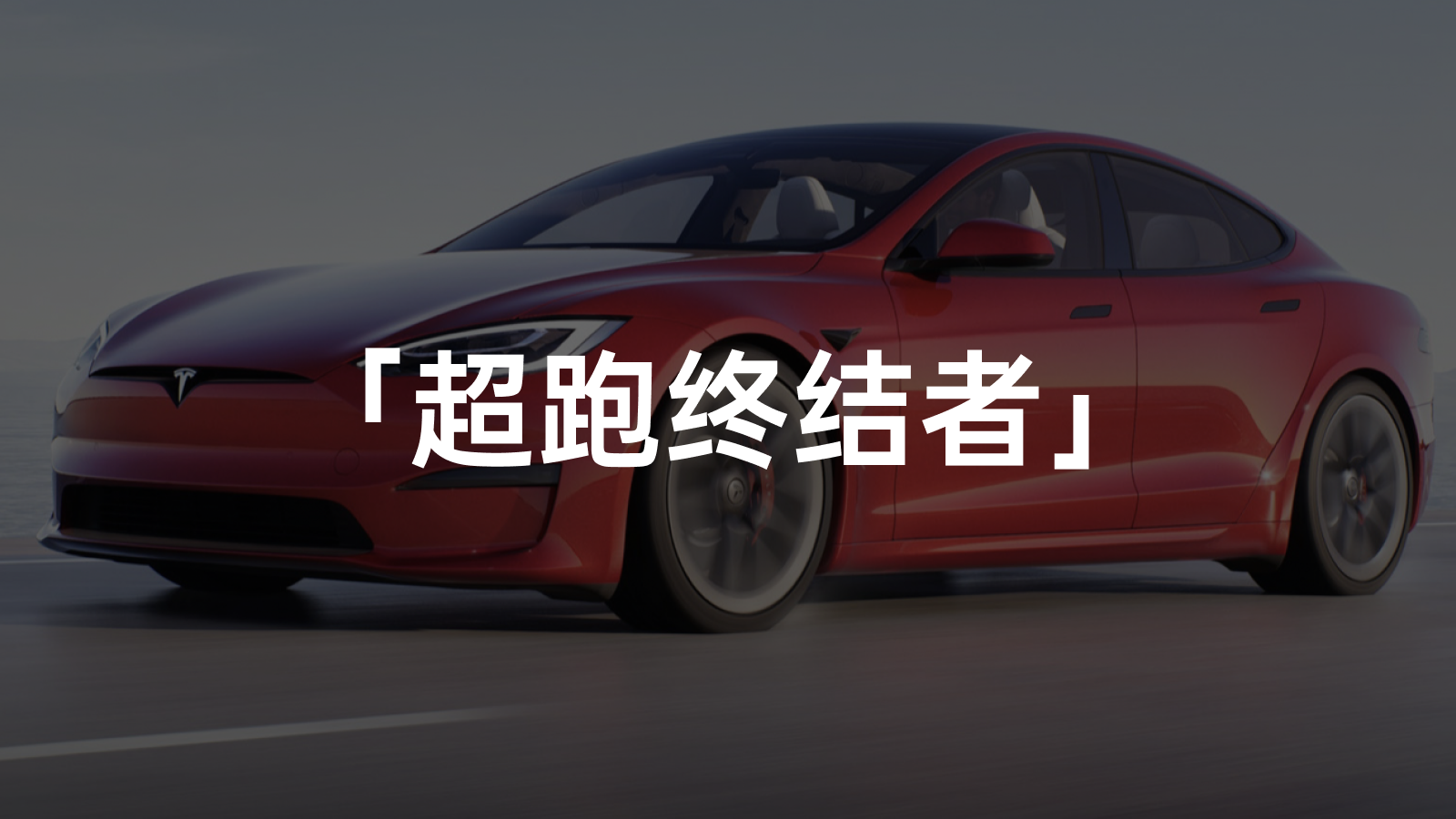On May 15th, Twitter user klwtts snapped pictures of the Model S Plaid prototype undergoing testing at the Weathertech Raceway Laguna Seca, revealing a retractable active spoiler providing strong downforce for the vehicle.
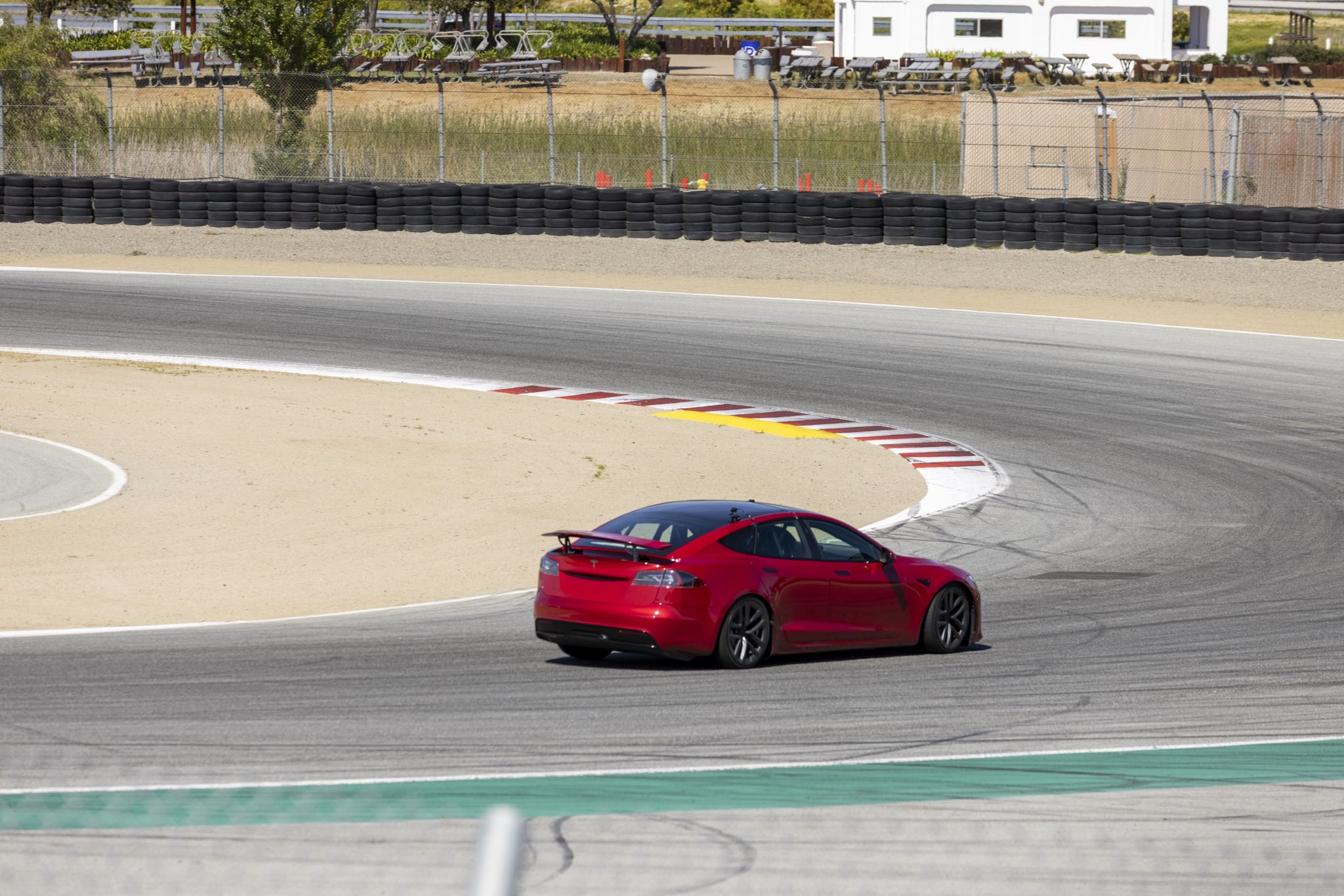
The soon-to-be-delivered Model S Plaid is preparing to break its own record as the “fastest production four-door car” on this track, and possibly dethroning traditional gasoline-powered supercars as well! Why say so? Let’s take a closer look.
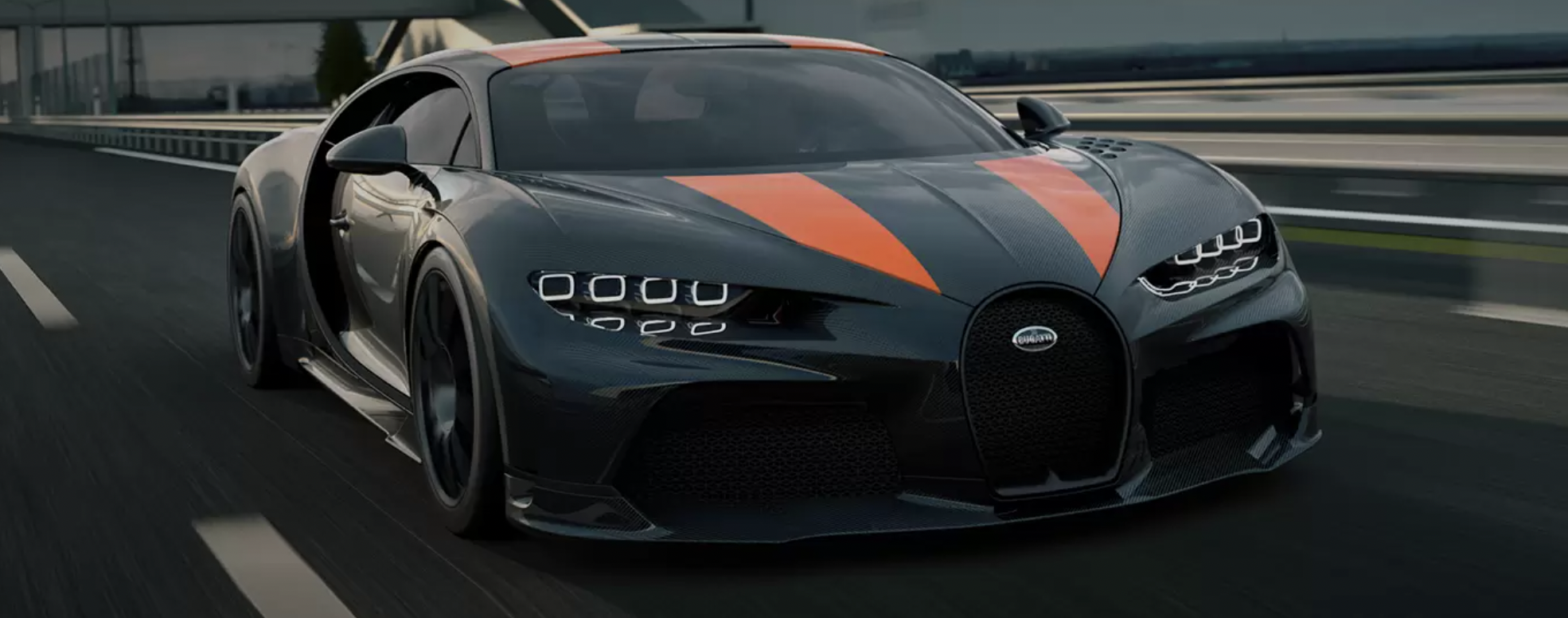
Bugatti Chiron Super Sport 300+ accelerates from 0 to 60 mph in 2.4 s and costs $3.9 million.
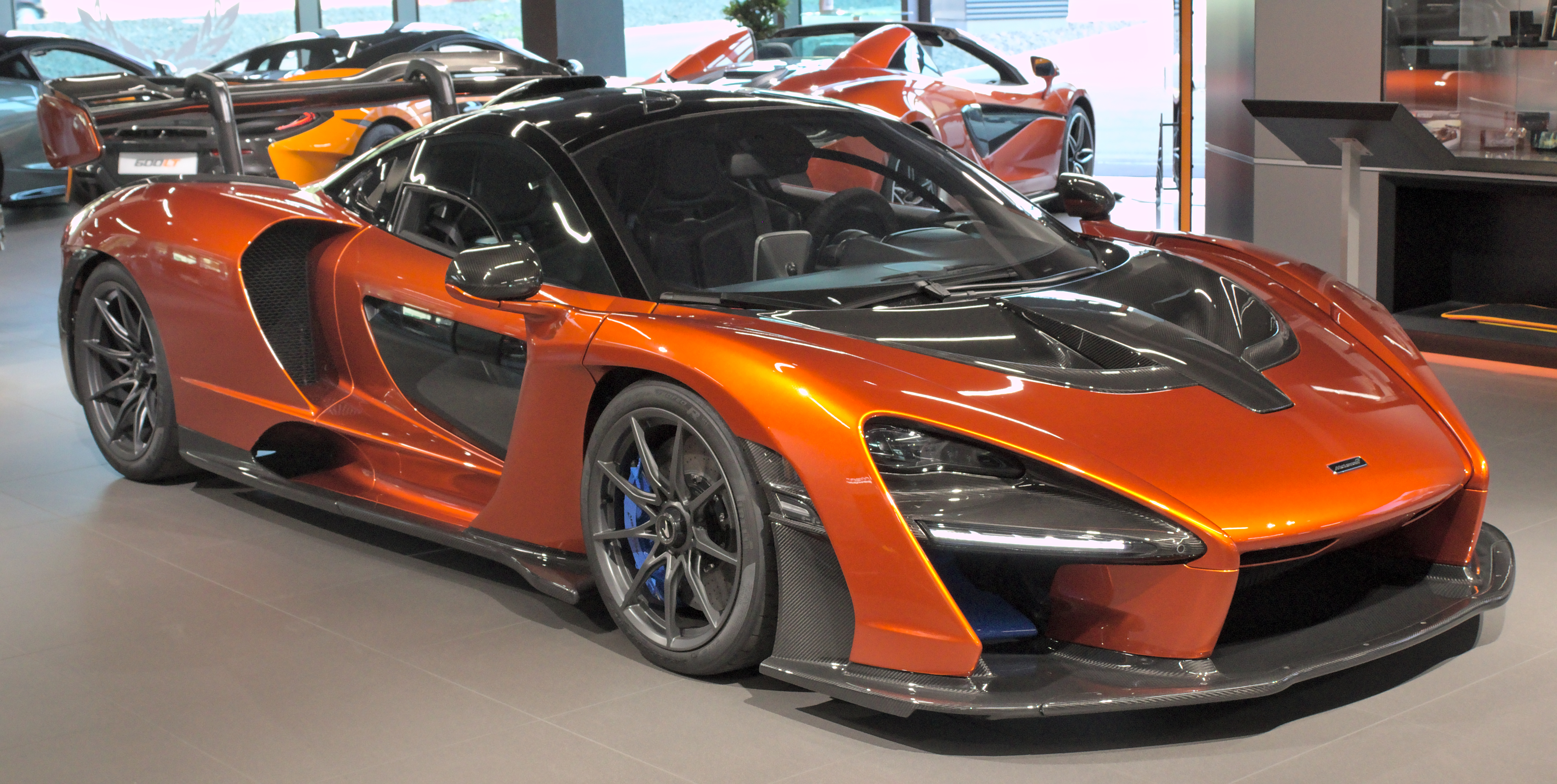
McLaren Senna accelerates from 0 to 60 mph in 2.8 s and starts at $1 million.
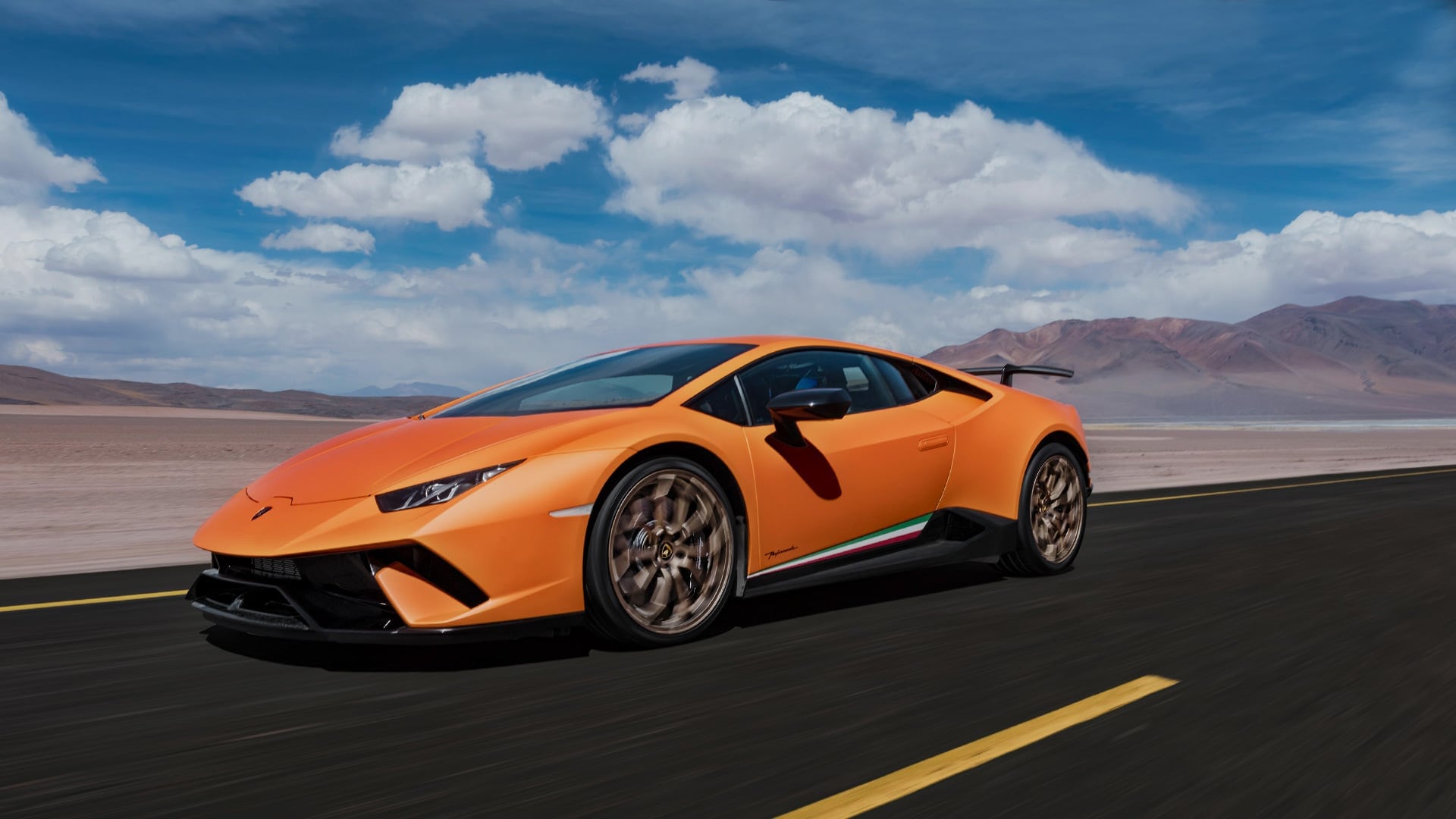
Lamborghini Huracán Performante accelerates from 0 to 60 mph in 2.9 s and costs nearly $300,000. This electric sedan, with “million-level performance,” is priced at only $140,000.
Today, let’s take a closer look at some interesting points of Tesla’s heavy-duty redesigned Model S at the beginning of this year. Here is a summary of the public information on the redesigned Model S series:
-
Lowest drag coefficient 0.208
-
Fastest 0 to 60 mph acceleration time 2.1 s (?)
-
Fastest 0 to 400 meters acceleration time less than 9 s
-
Maximum EPA range over 520 miles (about 840 km)
-
Yoke rectangular steering wheel
-
No physical gear shifter
-
Center console supports 3A single-player game masterpieces
Outwardly, there is almost no change.”Technology based on shell changing” is a phrase commonly used in the mobile phone industry to mock Nokia’s practice of only adjusting the appearance and claiming it to be a new product upgrade during sales. In recent years, people use this phrase to express dissatisfaction with insincere product upgrades.
Looking at the appearance of this redesigned model, even if they claimed it was the old version, I would believe it, as it is only a minor improvement. It is rare for people to be able to distinguish the two on the road without them being placed side by side.
Apart from minor changes to the front and rear bumper, side air flow lines, and tail wings, the overall appearance of the Model S has not changed much with the redesign. The most noticeable change could be the black, dense-spoke, hollow wheel rims which have improved recognition. Similarly, the Model X redesign has also resulted in minor changes to its appearance. The small changes to the overall appearance of the two flagship models make them look like the Model 3/Y.
Of course, the slight exterior adjustments made by Tesla were not to increase the identification of the redesigned models, but to improve their air dynamics. The special aerodynamic wheel hubs need to be selected for the best performance. The new diffuser design diverts airflow entirely with a diffuser instead of the negative pressure design used in previous generations. Additionally, the active brake air intake was directly removed, resulting in a lower air resistance front.
This has reduced the optimized Model S drag coefficient to 0.208, making it “the most aerodynamic production car on Earth,” with the lowest drag coefficient for a mass-produced car in the world!
However, soon after, Mercedes-Benz’s new EQS (0.20) stole that title just a few months later, relegating Tesla to second place in the world.
However, Tesla’s Chinese and global official websites even incorrectly labeled the drag coefficient as having units! There are no units for the drag coefficient! Here’s a post by a colleague at 42how: “Do you really understand the drag coefficient?” Hope that Tesla’s employees will take a good read of it.It can be said that the appearance changes of the upgraded Tesla flagship have no new ideas. After all, Model S has been released for 8 years, which is rare in the automotive industry, especially in recent years when the replacement cycle has been reduced to within 5 years. This shows Tesla’s confidence in this product, and of course the market agrees.
Although this upgrade still continues the old platform, the height of the rear seat cushion is the lowest in this price range (probably only 270mm), and you will understand what I mean when you actually sit in it. Therefore, even with such a huge flaw, Tesla still has a “honey confidence” in its own product.
Looking around us, our lives and work have been completely “soaked” by electronic products. From the updates of common electronic products such as mobile phones and computers, it can be clearly seen that the changes in appearance have become relatively sluggish, or less important.
On the contrary, consumers and brands will pay more attention to the improvement of hardware performance and software optimization and other “dimensions” that are invisible and intangible, thereby bringing updated user experience. Such an understanding of Tesla’s direction for product updates can reveal that Tesla tends to upgrade in a more inward direction towards intelligence.
This time, Tesla Model S and Model X have made significant updates and upgrades to the interior, motor, battery, electrical control, autopilot, and intelligent cockpit, in addition to the appearance changes. This is beyond the norm for the term “upgrade”, which implies the expectation of an impact brought by the real upgrade of Tesla models.
Interior renovation comparable to upgrading
The disappearing gear lever
Compared to the slight adjustment in appearance, the renovation of the interior can be said to be huge, and it also redefines the meaning of “upgrade.”
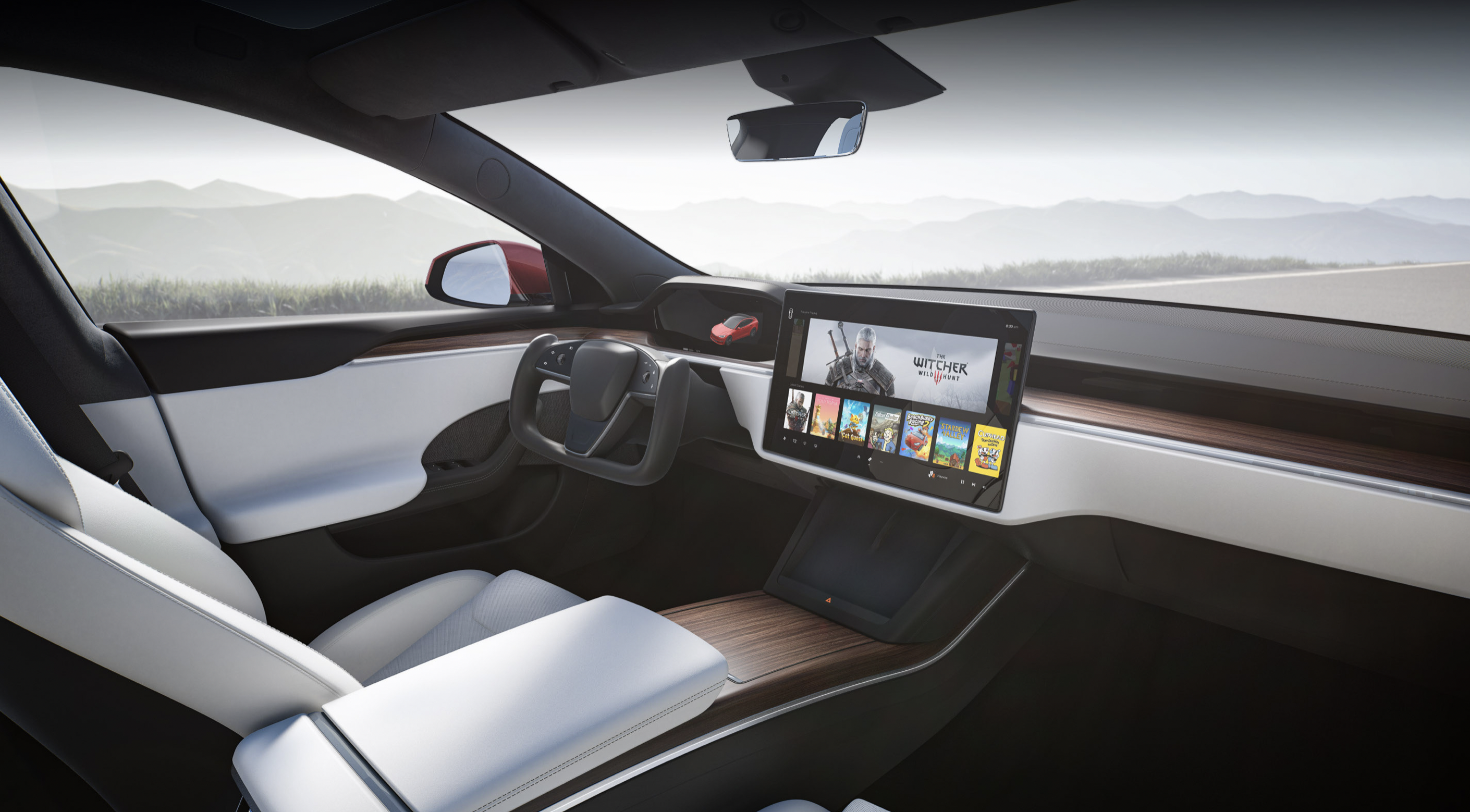
- Let’s start with a doubt: The gear lever has disappeared, how to shift gears?
First of all, Tesla’s official ideal usage method is to let the vehicle make decisions based on actual scenarios.
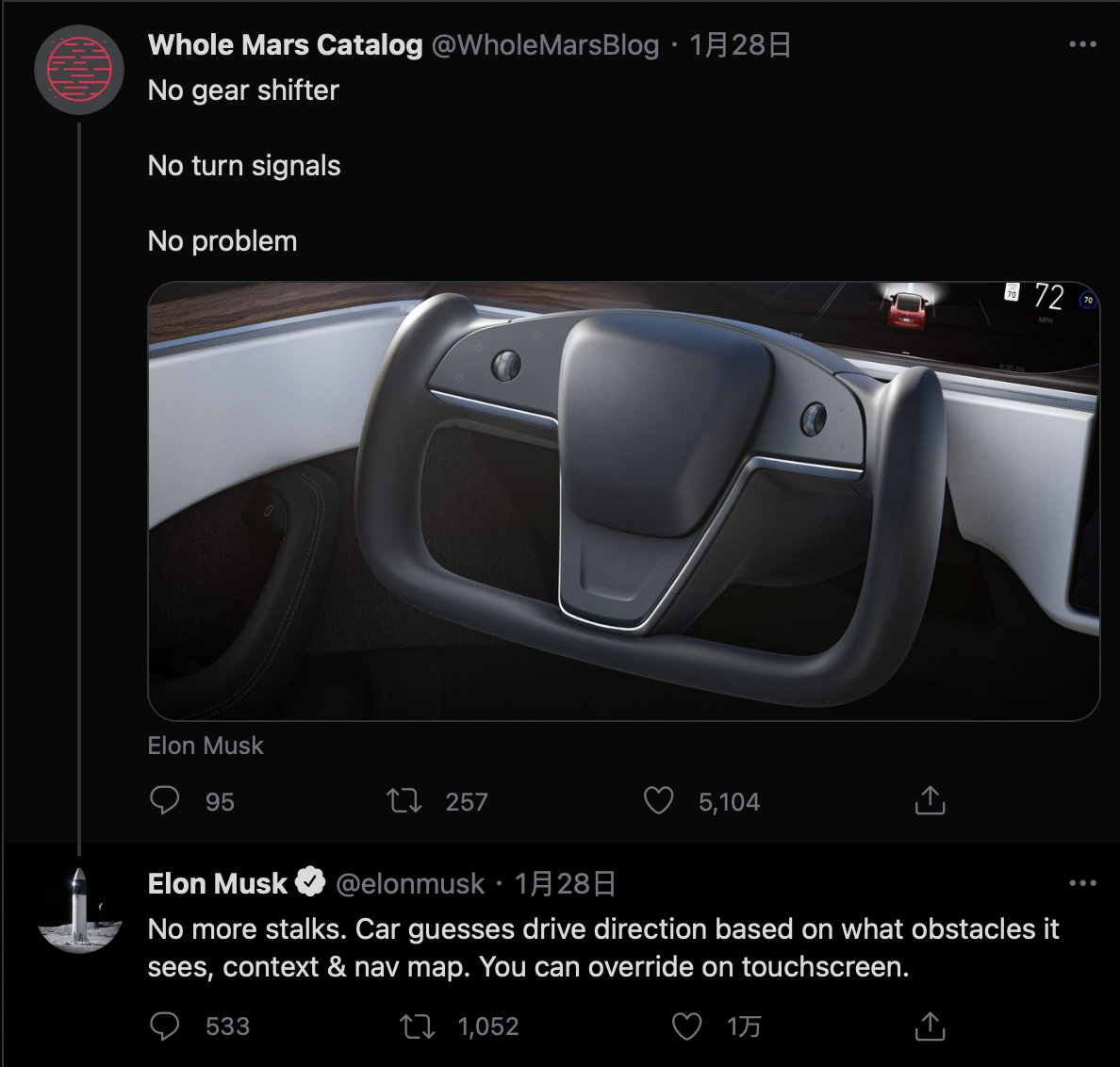 Ma Yilong mentioned in his response that vehicles will determine gear selection based on perceived obstacles or map navigation information, but the specific implementation of gear shifting is unclear.
Ma Yilong mentioned in his response that vehicles will determine gear selection based on perceived obstacles or map navigation information, but the specific implementation of gear shifting is unclear.
In Tesla’s internal documents, it is mentioned that vehicles will use Autopilot sensors to perceive the environment and automatically determine the expected driving mode and gear selection. For example, if the front of the Model S/X is facing a wall in a garage, the vehicle detects the wall and automatically switches to reverse gear when the driver steps on the brake pedal, eliminating the need for the driver to shift gears.
If the vehicle cannot determine the gear position when in an open space, you can easily switch gears on the left side of the Model S/X touchscreen.
- Of course, you may still have questions: How do you activate the turn signal? How do you activate AP?
The Model S/X eliminates two levers for gear control, which not only accommodates the vehicle’s gear control but also integrates commonly used functions such as headlights, wipers, and turn signals. Although automatic headlights and sensing wipers can already achieve very precise automation in use scenarios, how should active functions such as turn signals and AP be activated?
By zooming in on the steering wheel, we can find the “trick”.
The turn signal is integrated on two buttons on the left side of the steering wheel, which can be activated by touch. Even functions such as wipers and headlights retain touch-button functionality for active activation. However, AP does not have a separate button for activation.
It is speculated that AP may be activated by two wheels or a combination of buttons, and the possibility of touch operation is unlikely, as the cost of such activation is somewhat high.
- Is there really a Yoke steering wheel?
As for this Yoke rectangular steering wheel, opinions on it are mixed. Some people think its shape is sci-fi and innovative, while others think its practicality is poor and don’t know how to steer.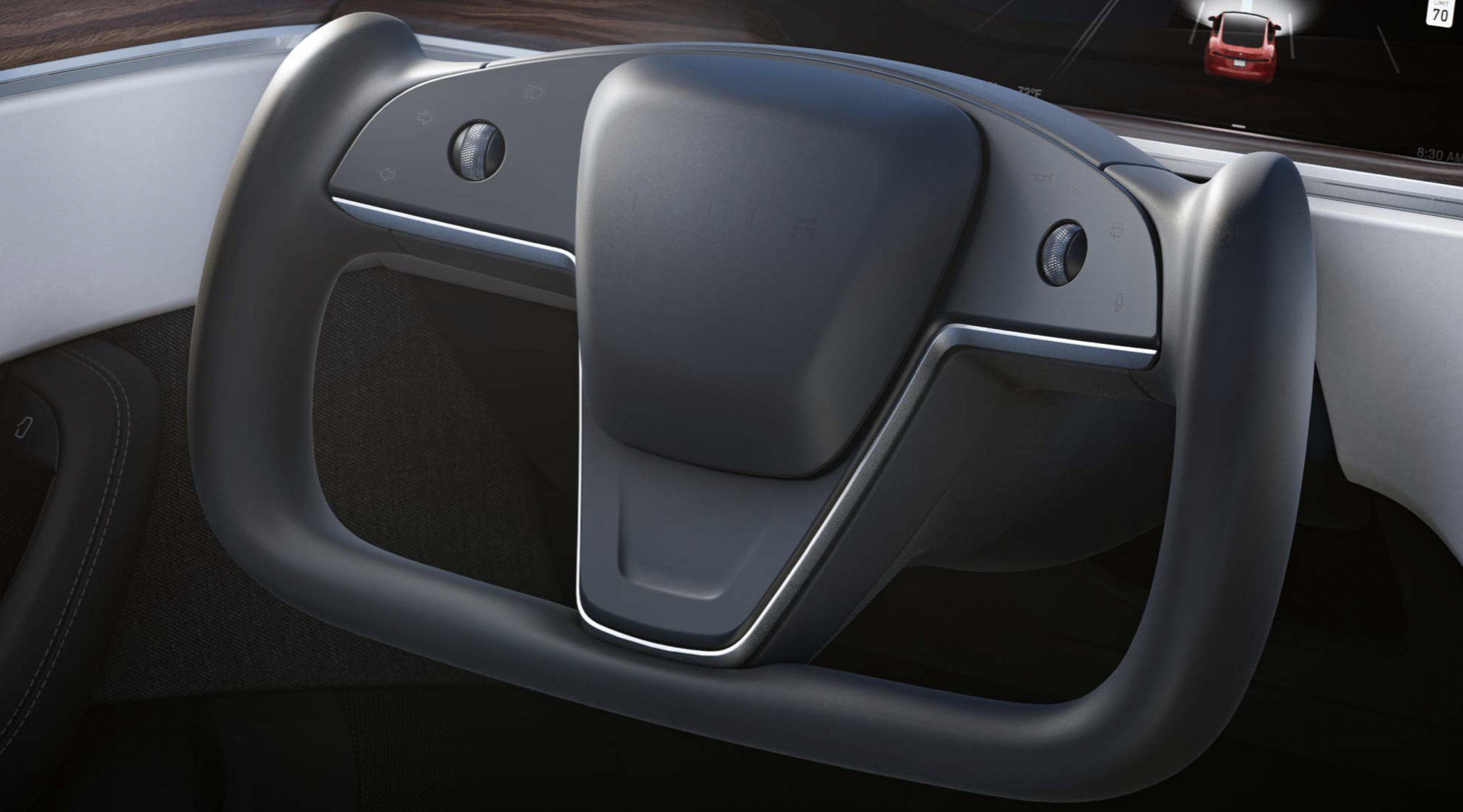
Although I have not personally used the Yoke steering wheel, from the analysis of the picture, it still supports the normal grip of the 3-9 o’clock position, which is more similar to the left and right symmetrical grip of the F1 car steering wheel. This may make it difficult for some drivers to accept.
The missing upper part of the grip is for better access to instrument information by the driver, and the instrument can be made as large as possible without being blocked by the traditional steering wheel.
Many people like to put their hands on the steering wheel during high-speed cruising, which is not a good habit. If this Yoke is included as standard equipment, then either choose to drive with the 3-9 o’clock grip on the steering wheel or directly let the AP drive. So Tesla may have developed this Yoke steering wheel to encourage users to use AP more. This is also related to the fact that the steering of Model 3 is recognized as heavy.
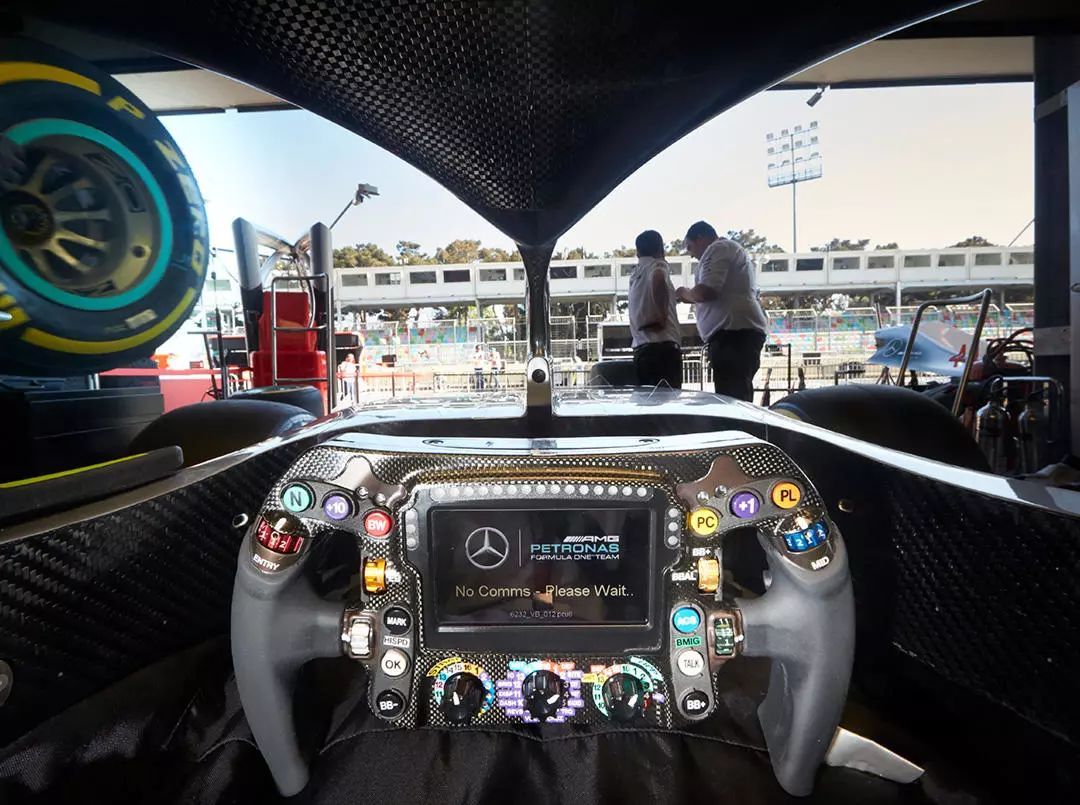
Currently, the Yoke steering wheel has been approved for use in several countries, including the UK and the Netherlands. However, whether the Yoke is an optional accessory or a specific configuration for certain models is still unclear.
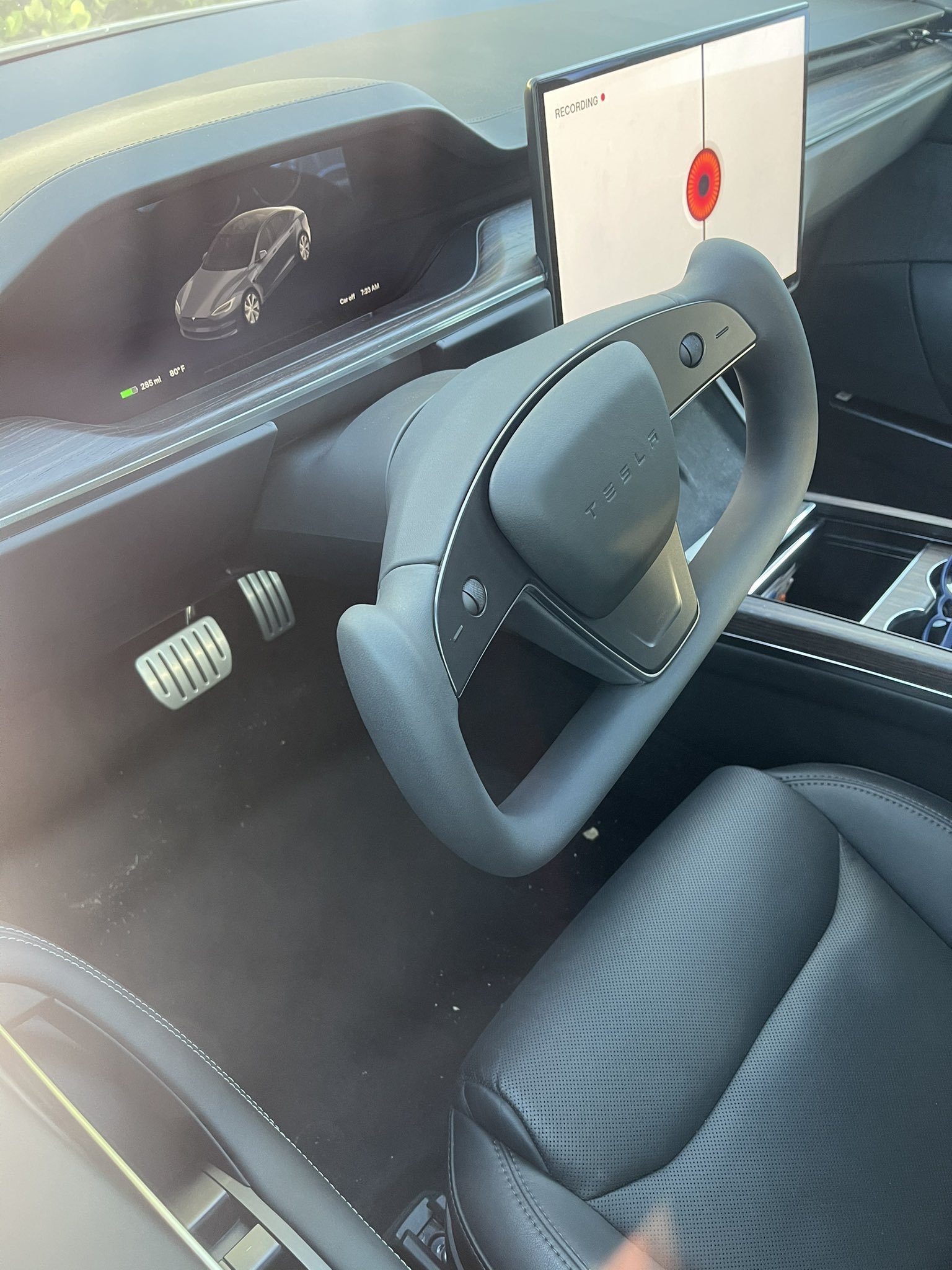
On May 11th, Twitter user AaronS5_ exposed a minor update to the Yoke steering wheel, adding a horizontal protrusion on the left and right for blind operation of buttons while driving. This design is similar to the small bumps on the F and J keys on our keyboards, mainly used to determine the position and directly distinguish “up and down”, so as to remember the position of the buttons.

Before official delivery, Tesla is making various adjustments to the new Model S / X.
Three Screens
In addition to the Yoke steering wheel and the disappearing physical shift mechanism, the most stunning aspect of the interior is the three screens.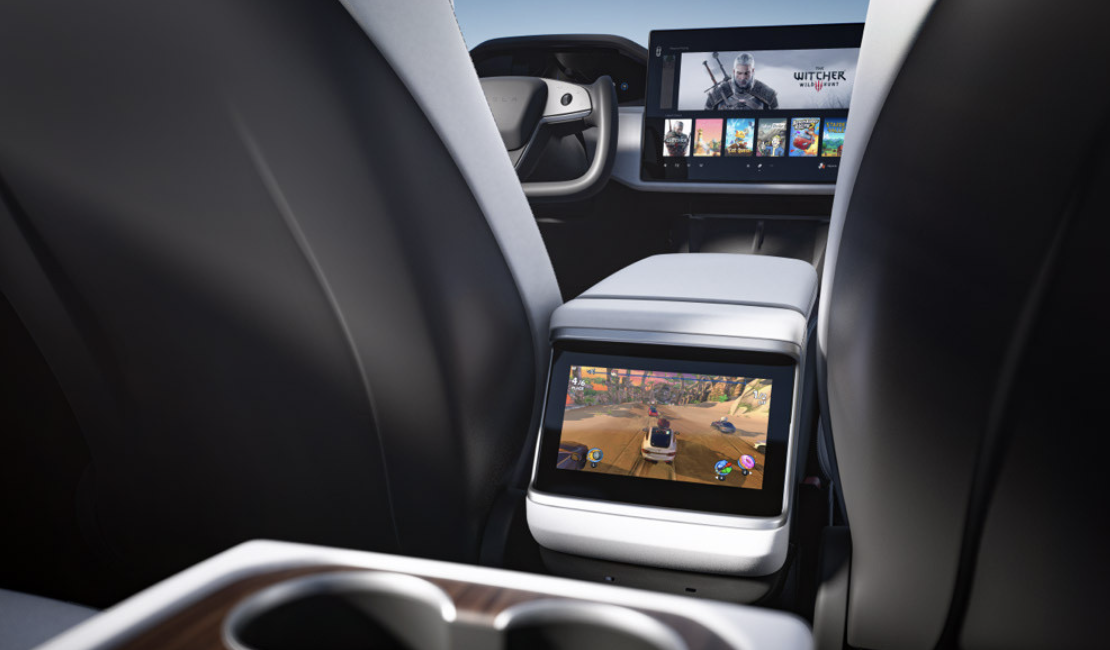
As a fan of AAA single-player games, I was shocked by the interior promotional poster featuring the cover of The Witcher 3 displayed on the central console. Of course, I admit that it’s one of my favorite single-player games, but that does not hinder my surprise. Although this game is an old work from 2015, and its requirements for PC configuration are not very demanding, running it on an electric car that is soon to be mass-produced was a surprise that I had not expected.
The size of this central console screen is 17 inches, with a resolution of up to 2200 × 1300, using a landscape screen similar to that of Model 3/Y, powered by an Navi 23 RDNA 2 GPU from AMD, and has a computing power of 10 teraflops. You may not have an idea about this computing power, but to describe it simply, it can compete with the most powerful game consoles currently available, PS5 and Xbox Series X, which provide GPU computing power of 10.28 teraflops and 12 teraflops, respectively. Therefore, it can be said that the use of language such as “comparable to next-generation game console PS5” in its promotion is quite accurate.
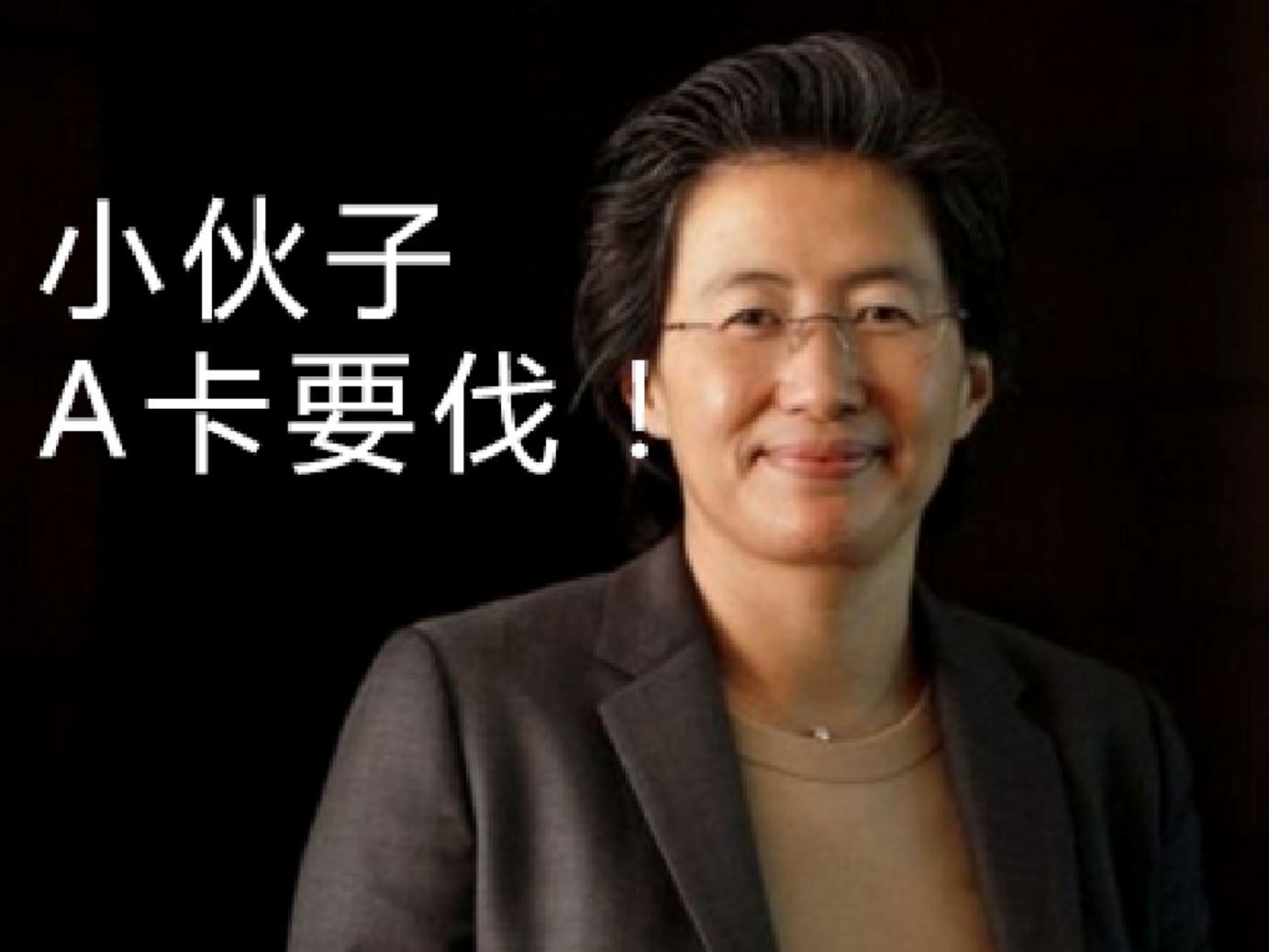
This graphics card also provides four 2GB GDDR6 memory modules, and uses the PCIe 3.0 x 8 channel. Most importantly: It supports ray tracing! It supports ray tracing! It supports ray tracing! Please put “Sue is awesome” in the chat!
What is ray tracing? Here is a brief introduction, which is not very relevant to the main theme of this article. The full name of ray tracing is Deep Learning Super Sampling (DLSS). It generates highly realistic images by simulating the physical behavior of light rays, requiring a lot of complex computational work.
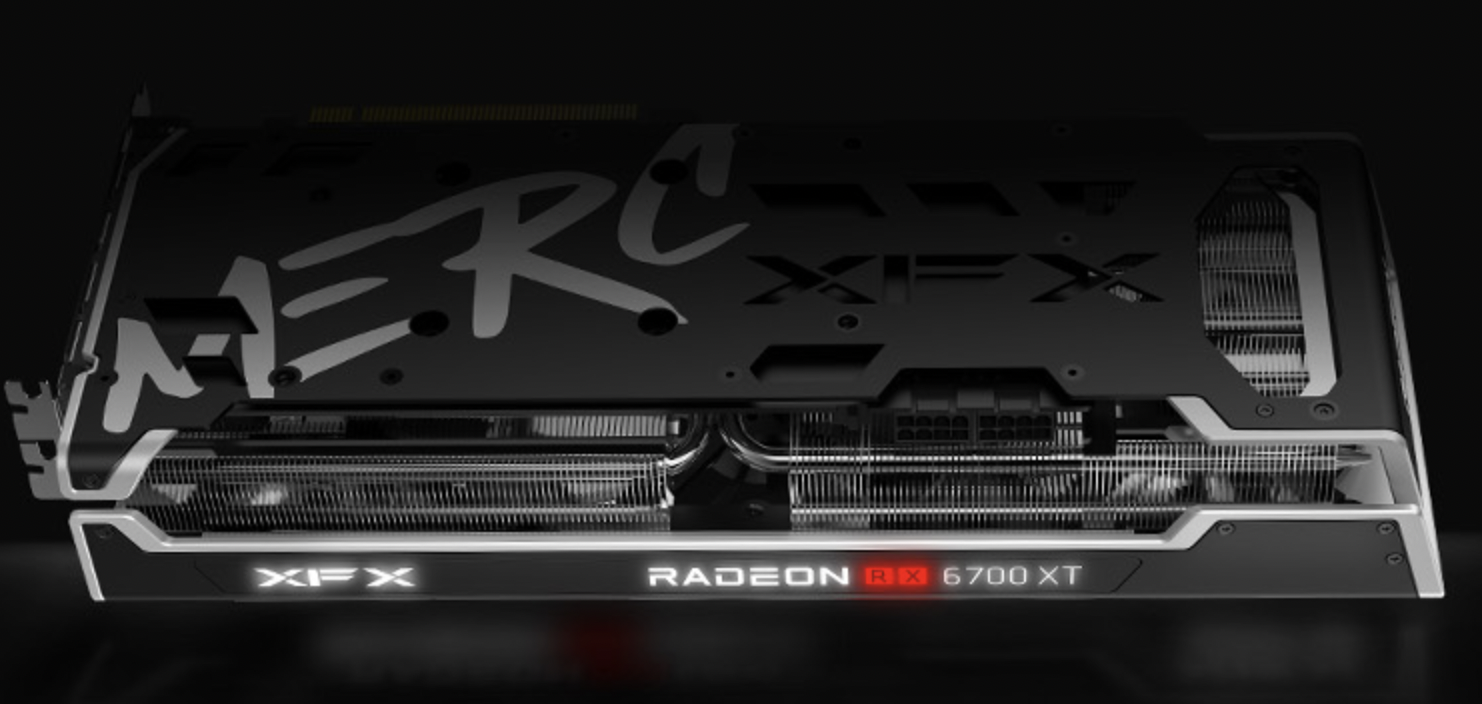 Translated English Markdown text, preserving HTML tags:
Translated English Markdown text, preserving HTML tags:
After discussing so many parameters, you may still have no idea about this graphics card. On the PC side, the RX 6500 series graphics card, built with Navi 23 RDNA 2 technology, directly competes with the RTX 3060. Running current AAA games with 2K resolution and 60 frames per second is no problem. So, actually putting The Witcher 3: Wild Hunt on the promotional page is quite “modest”, and Cyberpunk 2077, which supports ray tracing, could also be included, as it is the latest AAA game.
Moreover, a grand plan pops up in my head: Ma Yilong can create his own “MaCoin”, which can only be mined using special Tesla models. Then, he can announce that buying a car can be done using “MaCoin”, forming a perfect loop.
Of course, the car infotainment system needs to support connecting to Bluetooth game controllers, and the small screen for rear entertainment also needs to support game controller connection. As for why the dashboard screen is kept, combining with the previous text, it’s obvious that the 17-inch screen on the center console is for providing entertainment for all car passengers, and the screen can be adjusted left and right, while the dashboard is specifically for the driver to read information.
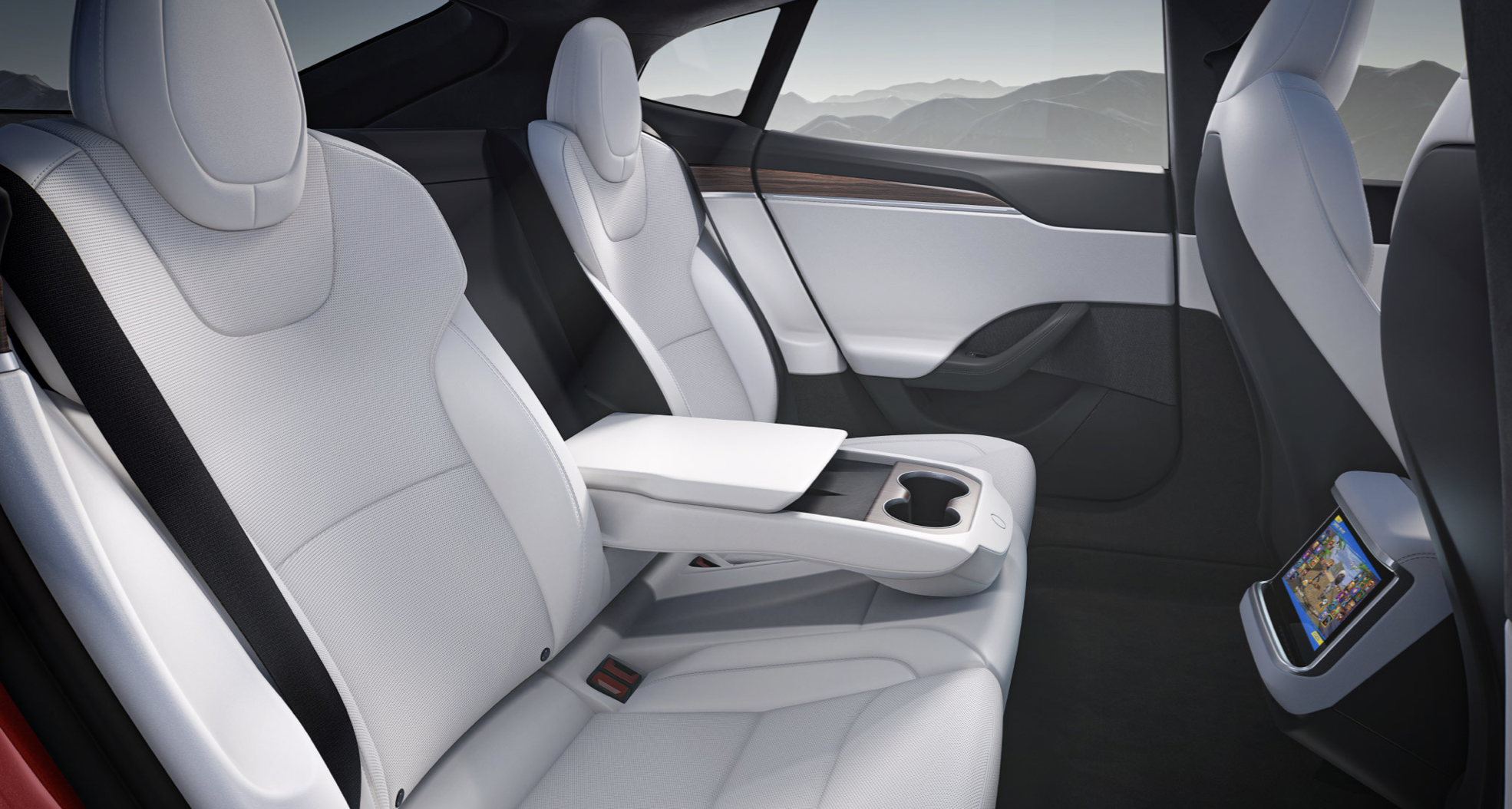
However, when using the rear screen for audio and video entertainment, the screen is relatively small and has a low angle, so the passenger posture may not be very comfortable, and the experience of the previous generation of rear seats was also poor, so the actual usage scenarios may be reduced.
Plaid = Ultimate Acceleration + Ultimate Performance
This time, the Plaid version completely replaces the previous Performance model. However, the translation of Plaid has nothing to do with performance, just like you, I also have the same doubt.
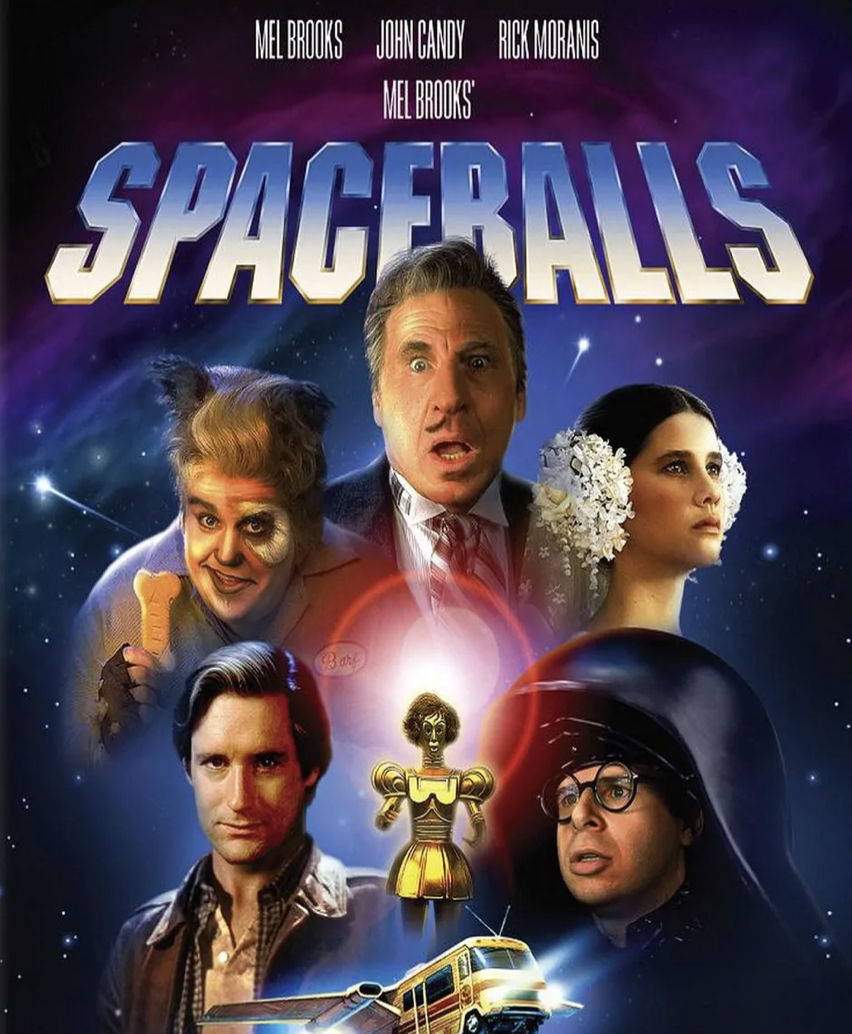
Tesla’s naming of Performance comes from an old movie called “Spaceballs”, which is a parody of the “Star Wars” series. As the name implies, this movie is meant to make fun of “Star Wars”. “Ludicrous Mode” and “Plaid” both originate from the line “After ludicrous speed, you go plaid” in this movie. After reaching Plaid speed, objects are torn into a grid pattern, describing a speed that is extremely fast.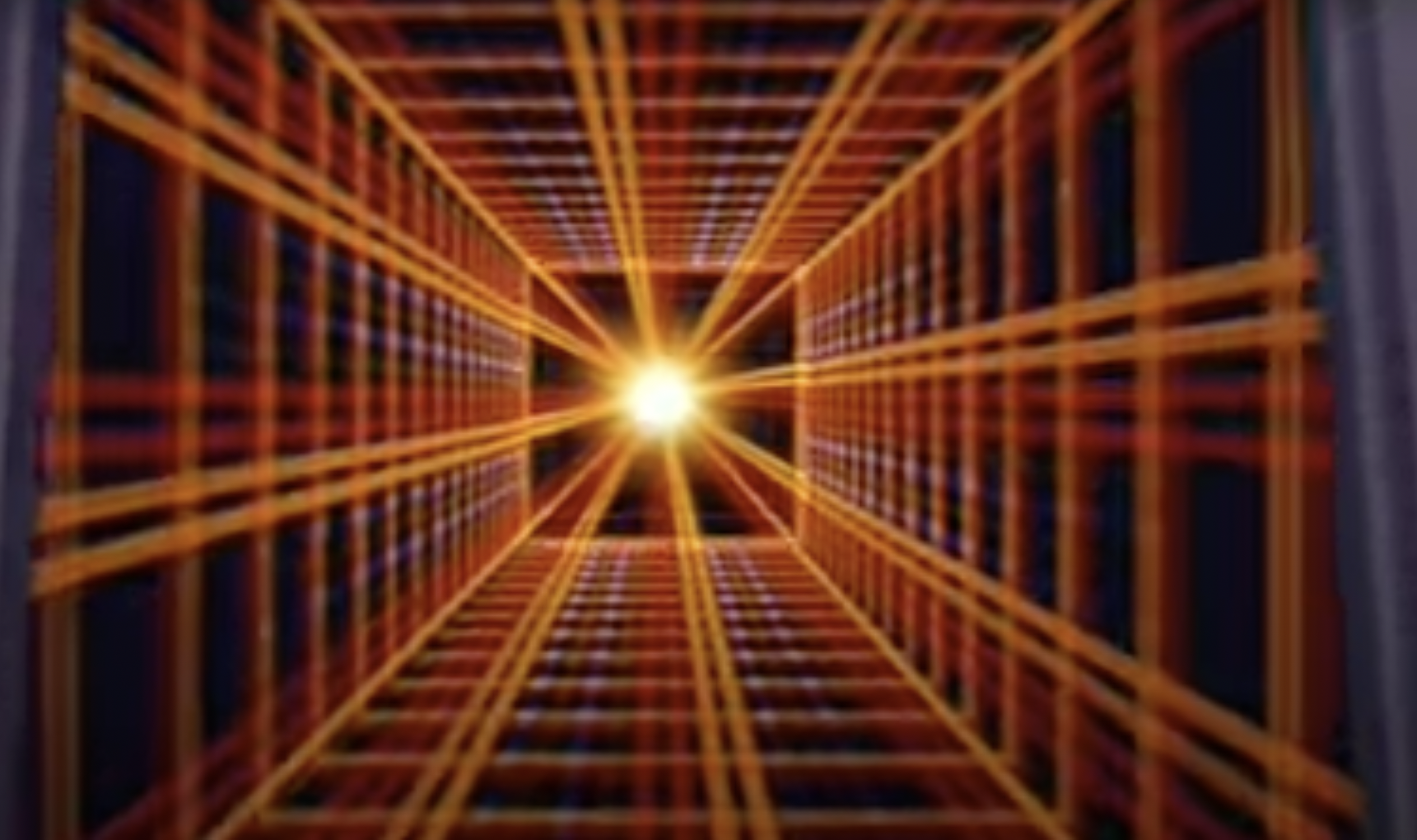
At last year’s Battery Day in September, Ma Yilong used “The only thing faster than ludicrous” to describe the ultimate performance of the Plaid model.
True or False 2.1s
Let’s review the acceleration parameters of the Model S Plaid Plus version: the acceleration time within 2.1 seconds per 100 kilometers, and I deliberately added a “?” at the beginning.
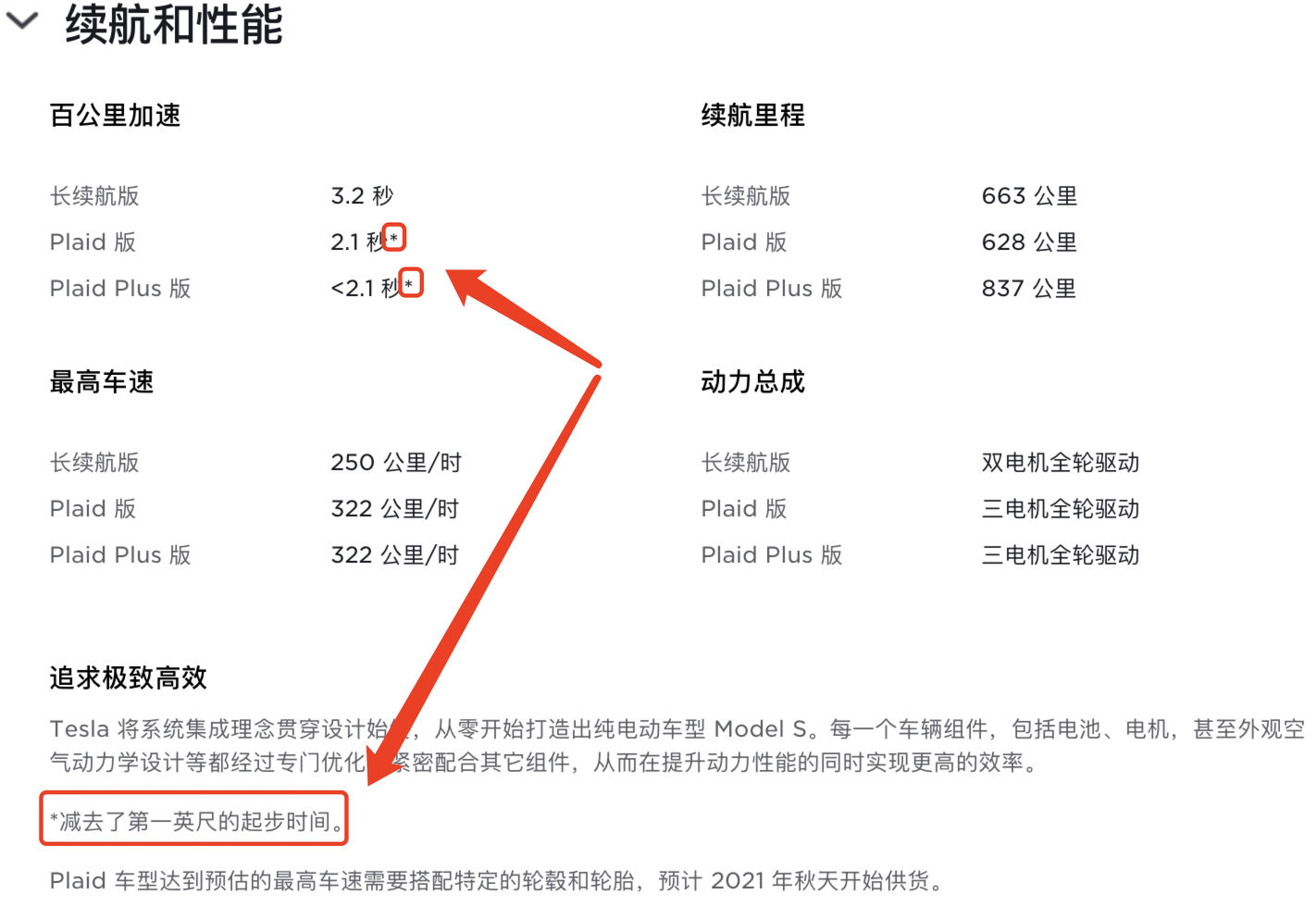
Reading the official *content carefully, you may wonder what “minus the first foot start time” means?
First of all, in the quarter-mile straight-line acceleration race, the actual acceleration time and test acceleration time are slightly different, and the speed of reaching 60 kilometers/hour after the front wheels have pressed the “STAGE” line are usually used as the test acceleration time.
The time from the vehicle standstill to rolling over the “STAGE” line is called the “first foot start time”. For electric cars, this value usually means at least 0.2 seconds or more of time, and the size of the wheels will also affect this value.
This is quite different from what we Chinese usually think of as normal acceleration from 0 to 100 kilometers/hour. But Tesla hasn’t explained this too much, instead, it adopts two different acceleration test standards for annotation at the same time.
It is speculated that this may be to create a huge performance difference between the Peformance, Plaid versions and ordinary models. Therefore, the acceleration of less than 2.1s requires an attributive phrase “minus the first foot start time”, and the description of “the only mass-produced car that can accelerate from 0 to 60 mph in 2 seconds in the world” naturally requires this attributive phrase as a prerequisite limitation.
Scary Top Speed
Even with an acceleration of 2.1 seconds, the Model S Plaid Plus version can still push its top speed to 322 kilometers/hour, which should be the ceiling of the top speed of electric cars at present. It is worth noting that Taycan Turbo S next door starts at 1.8 million yuan and can only reach 260 kilometers/hour at top speed, not to mention acceleration (crying/ laughing).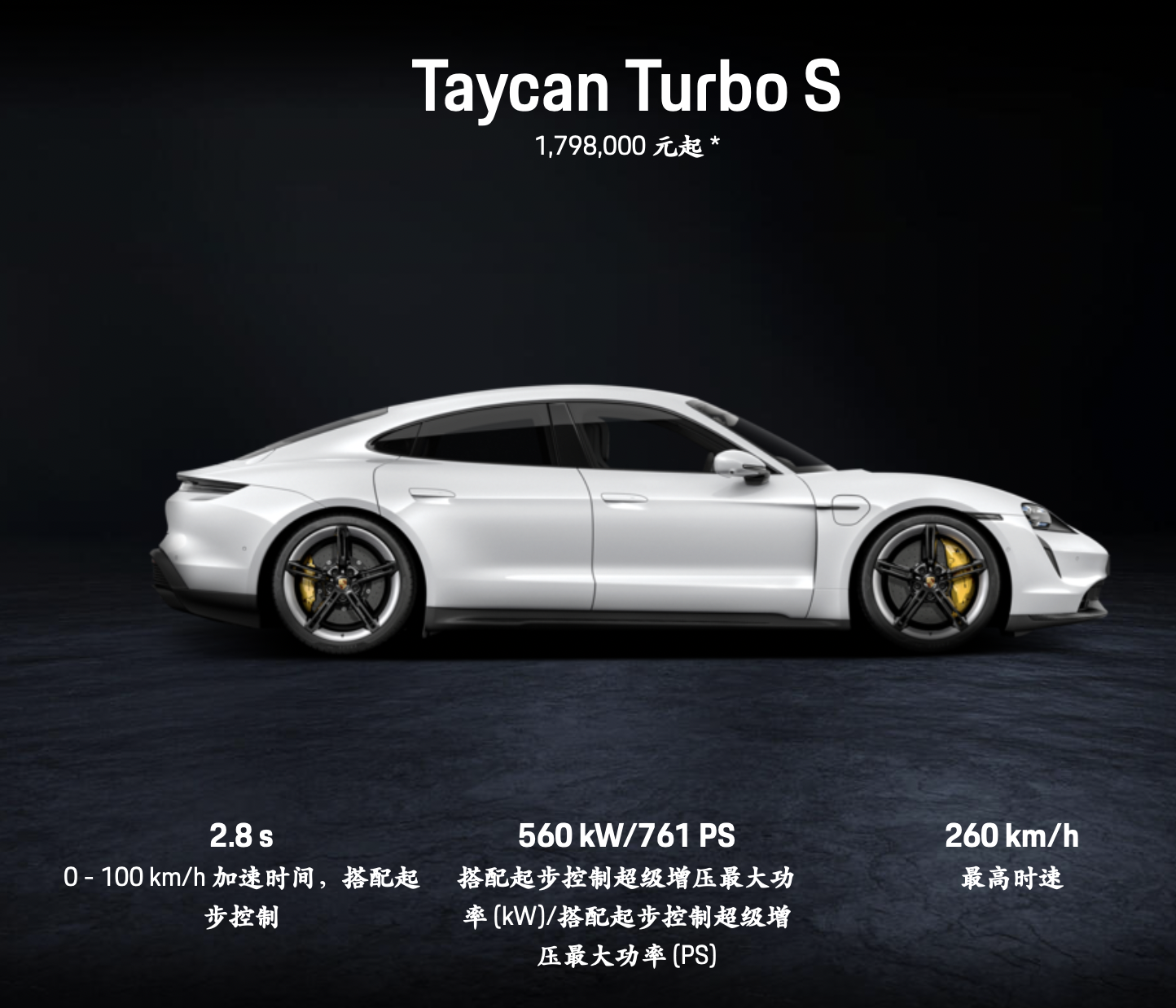
Actually, it’s quite difficult for an electric car to achieve high speed, as it relies solely on the motor without the assistance of a gearbox under the condition of speed climbing. In contrast, the Taycan Turbo S, which may be the only competitor currently on sale, uses a two-speed gearbox for power transmission to achieve a top speed of 260 km/h and a 0-100 km/h acceleration time of 2.8 seconds for the ultimate acceleration experience.
According to Porsche’s official description, the two-speed transmission on the rear axle is designed for “high efficiency” and “high power reserves.” This actually demonstrates the significant advantages of Tesla’s motor performance in torque, power, and maximum speed, and there is no need to balance efficiency and performance with such mechanical gears. It is not like what some big V said that the two gears are designed for “ultimate performance.”
Currently, the Model S Plaid Plus, with 1,020 horsepower, has won in terms of acceleration efficiency compared to the Taycan. And considering the respective range requirements of Tesla and Taycan, Model S is expected to completely outperform Taycan in terms of energy consumption as well.
However, as a four-door electric sedan, the Model S can learn from the Taycan to place the battery pack under the rear seats, release the height of the seats to the chassis, and obtain a relatively comfortable riding experience.
The Ultimate Handling
Such a definition for the redesigned Model S will surely draw criticism, but please continue reading.
- Will the CTC packaging affect the handling?They say that electric cars have a low center of gravity, minimal body lean, and a responsive acceleration, making them the envy of other drivers. But how do electric cars benefit from these advantages when it comes to improving their handling performance?
The updated Model S uses 4680 batteries that are packaged together in a Cell-to-Chassis (CTC) arrangement. In simple terms, the batteries are arranged in a honeycomb-like structure that integrates the battery pack with the chassis to provide support. But how does this relate to handling?
With the support structure of the battery pack eliminated, the batteries can now be more compactly arranged closer to the center of the car. This improves weight distribution, reduces the moment of inertia, and enhances handling response at the limit. It also improves side-impact safety protection of the battery.
To help us understand the benefits of the CTC process, Mr. Ma Yilong (马一龙), a Tesla product manager, likened it to the sport of figure skating: when performing a rotational movement, the action of the arms affects the moment of inertia, which in turn affects the rotational speed. By tightening the arms, the moment of inertia decreases, and as a result of the law of conservation of angular momentum, the angular velocity increases. Simply put, the closer the weight distribution is concentrated at the center of gravity, the more agile the car will handle.
Tesla’s use of a Multi-Function Structure Adhesive (MFSA) is crucial to the CTC packing process as it has both structural bonding and fire-retardant properties. The MFSA appears to have met these requirements, and Tesla is said to have started ramping up production. However, one question remains: with the increased packaging density, cooling is a greater concern. How is Tesla addressing the thermal management issue? Perhaps the MFSA has an additional role as a thermal conductor?
Back to the Model S Plaid: the two motors mounted on the rear axle provide a significant improvement in handling performance during sharp turns thanks to Tesla’s use of the NSX’s SH-AWD technology. The original principle of the technology is that the two independent front motors can create a vector twist during cornering. By accurately controlling this torque, the regenerative braking force on the inside wheel can be adjusted, and the torque on the outside wheel can be increased, allowing for faster cornering without slipping.Rimac and Lotus are both developing four-wheel independent electric motors that are more powerful and efficient. The latest Ferrari SF90 Stradale also uses a dual-motor setup similar to the NSX front axle.
Compared to torque vector control developed on top of ESP, the separate control of the motors is more efficient (energy recovery), faster, and extremely precise.
The motor layout in Model S Plaid should be two motors at the back and one at the front. Such a layout greatly improves cornering performance.
- Enough talk, let’s look at the results.
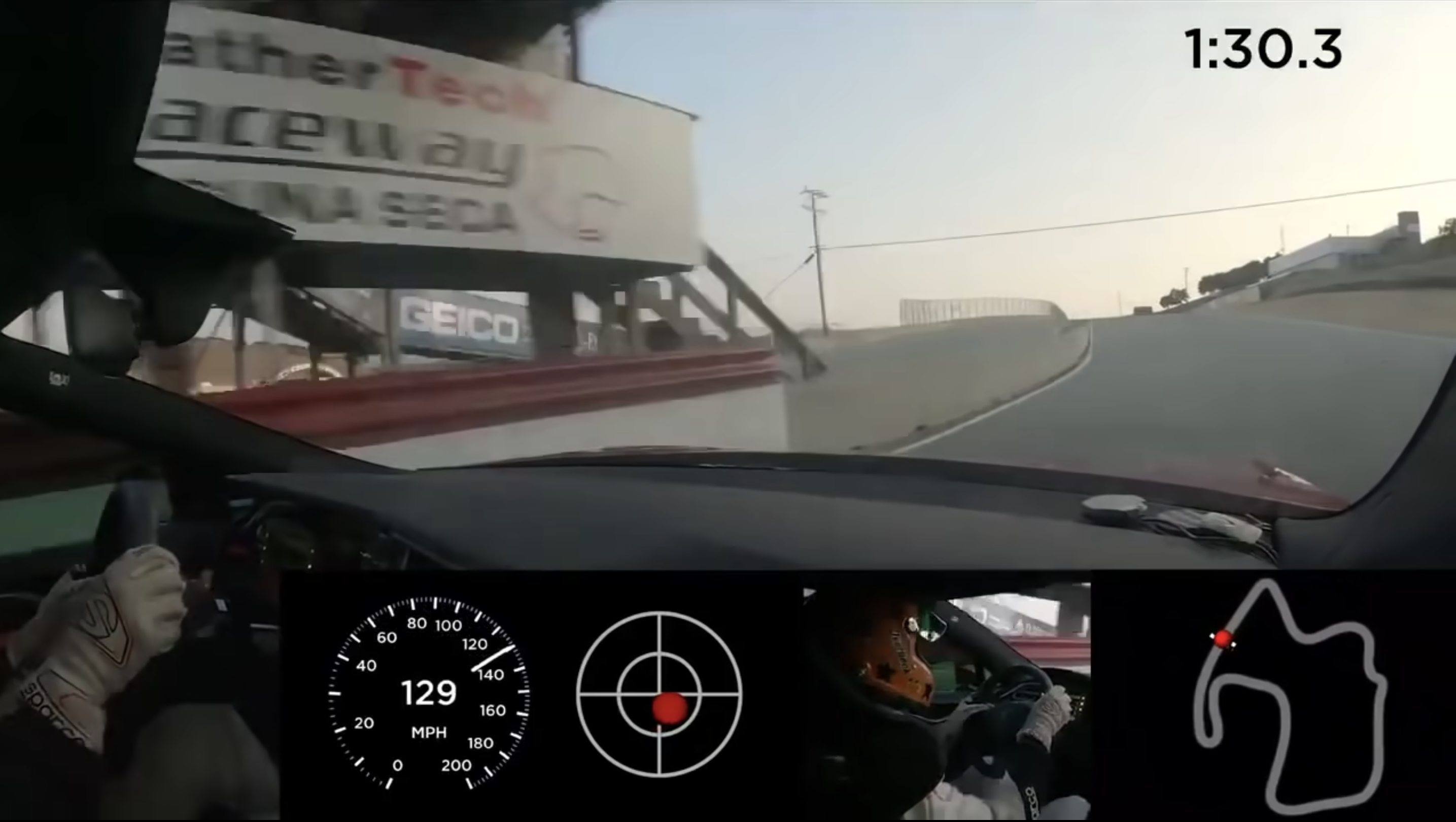
After talking so much about the mystique of handling, let’s take a look at the real lap time on the track. Ma Yilong claims that the prototype of the Model S Plaid can complete a lap at the WeatherTech Raceway Laguna Seca in 1:30.3 seconds.
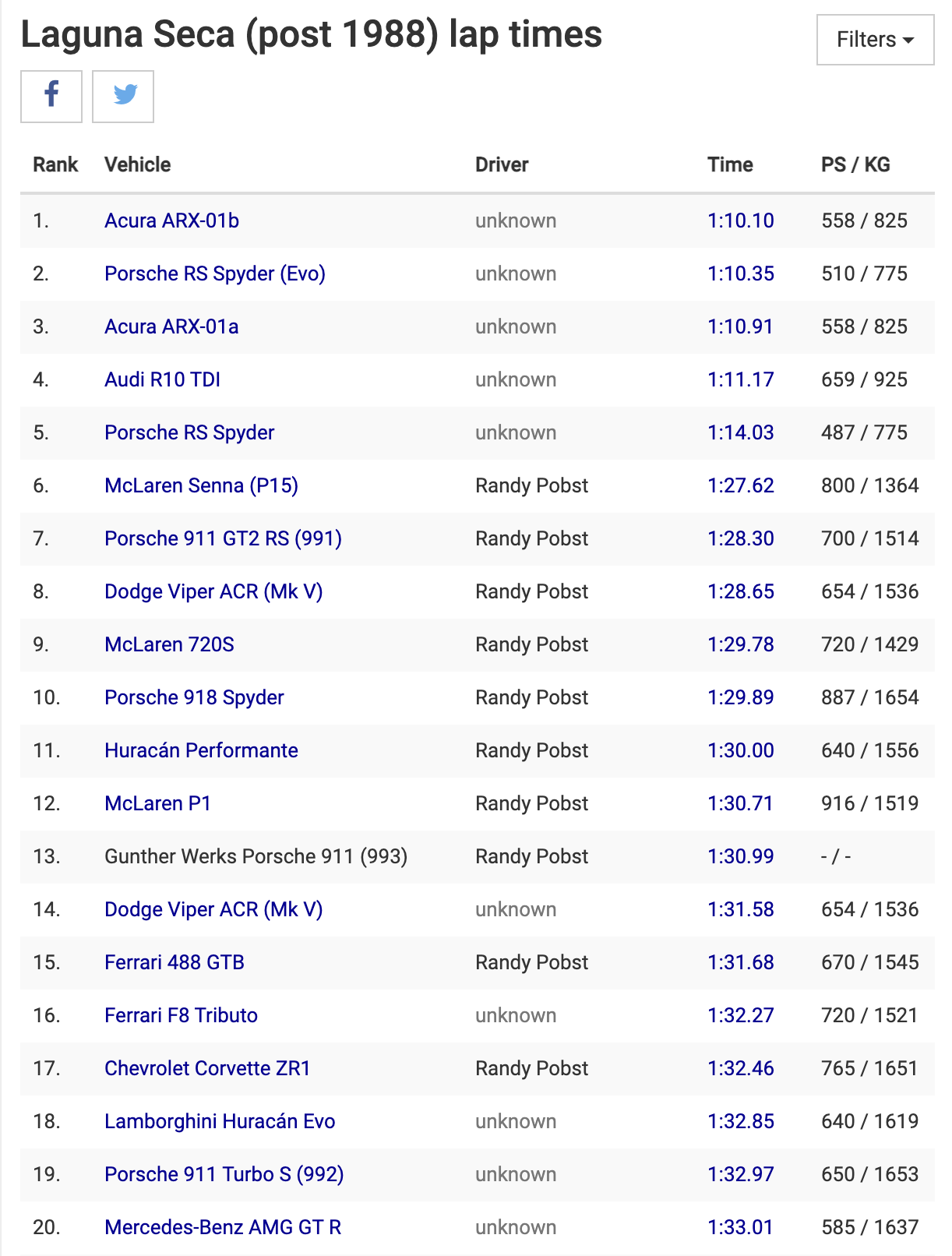
Let’s take a look at the lap time ranking at the Weathertech Raceway Laguna Seca. What kind of role do those who are brothers with the updated Model S Plaid Plus play?
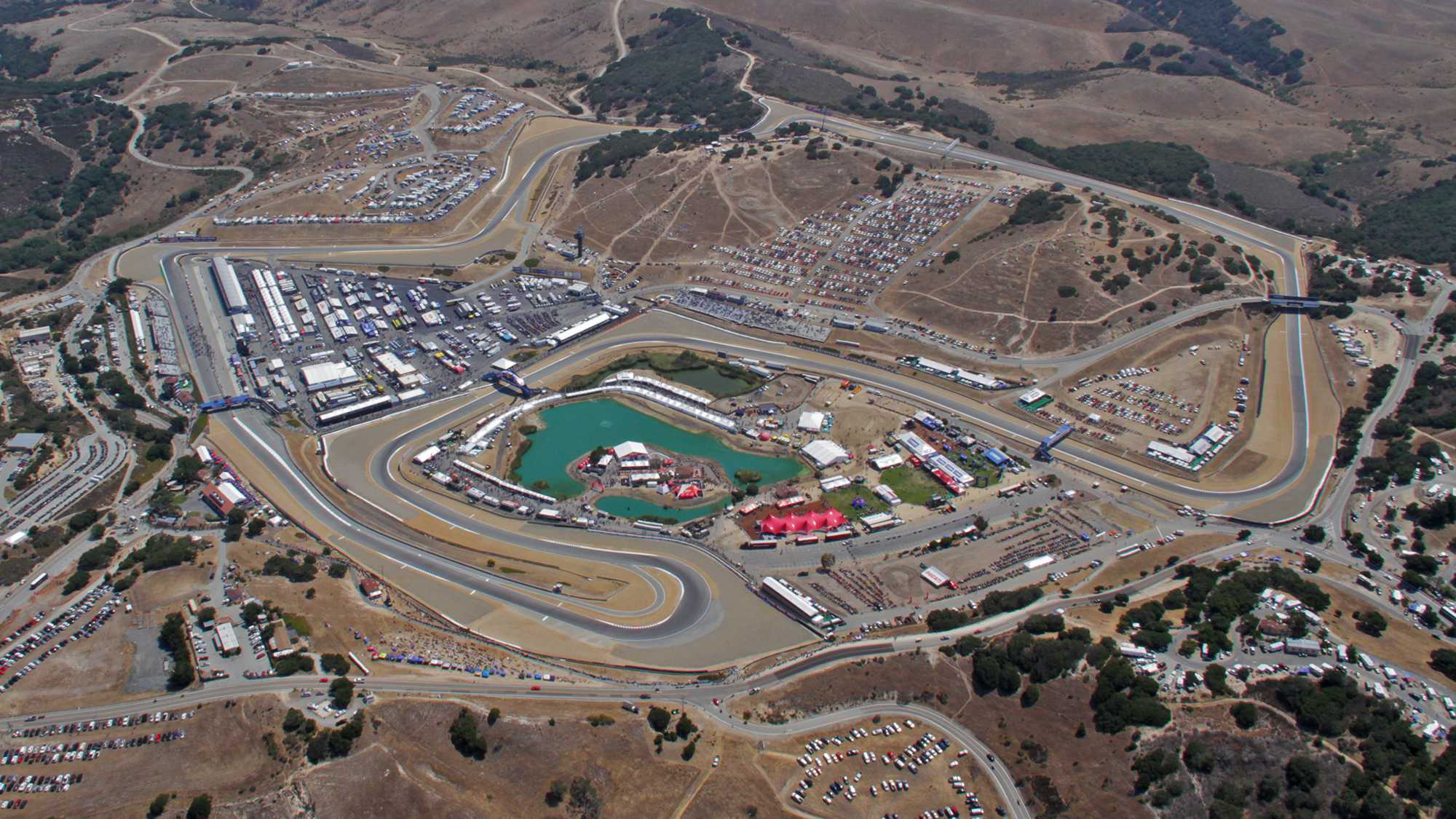
Lamborghini Huracán Performante, McLaren P1, and even Ferrari 488 GTB and F8 Tributo are all little brothers. Compared to the prices of these supercars, Model S Plaid Plus with a price of just over 1.2 million is a cost-effective option.
So we need to add some qualifiers for the Tesla Model S Plaid Plus, such as four-door, sedan, and mass production. Then it will be the fastest mass-produced four-door sedan in the world! And this car is just a prototype that will probably become even faster after optimization.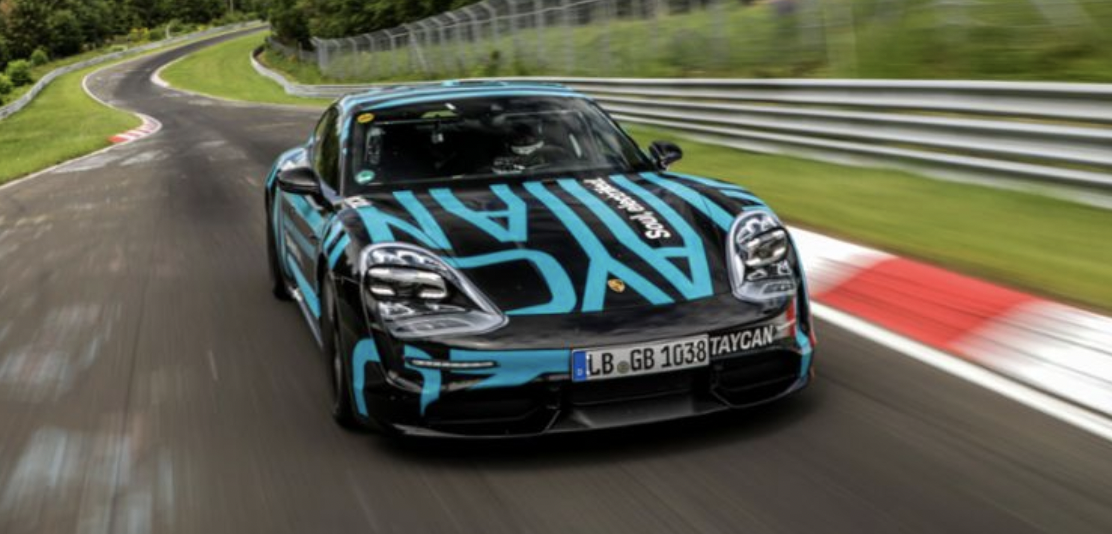
Of course, having such a strong foundation, challenging the racetrack of the Americans alone is not enough to prove anything. Tesla is also preparing to challenge the Nurburgring racetrack. According to the telemetry map released by Tesla last year, the Model S Plaid prototype completed the test in about 7 minutes and 20 seconds, which is more than 20 seconds faster than the Porsche Taycan. And this was only an informal test last year, the actual time will be even shorter!
As time goes by, more racetrack results will be announced, and the name of Model S Plaid will continue to be at the top of the list. The dynamic limits of the Model S Plaid Plus have not yet reached their limits, and it is even possible to use OTA upgrades to compete with new rivals.
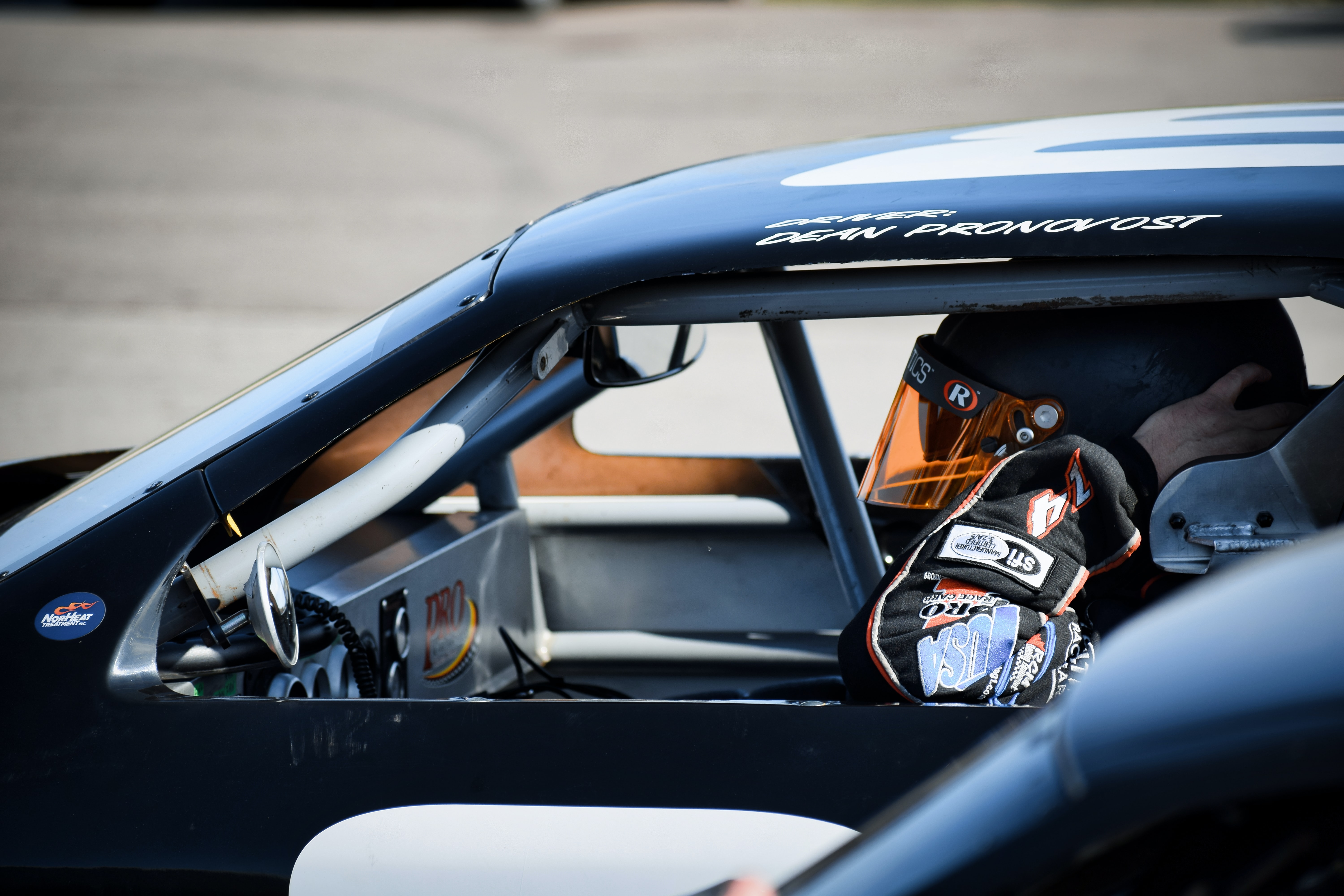
Of course, the safety of acceleration is a serious topic that must be mentioned. On the one hand, it is for the driver himself, and on the other hand, it is for other traffic participants. Because the upper limit of the acceleration G value that a normal adult male can withstand is generally after 2-3 G, there will be dizziness, and fighter pilots can withstand 5-7 G. The wild acceleration of the Model S Plaid Plus version will reach a peak G value of more than 1.5 G, and ordinary people will likely experience grimacing and dizziness when using it directly.
This undoubtedly poses a threat to the driver’s own driving safety and the safety of other traffic participants. However, it seems that the “arms race” of acceleration in the electric vehicle industry cannot be stopped. Although we cannot contain our excitement, we still believe that we need to have respect and relevant training for acceleration.
Finally, we need to face Model S’s potential pure electric opponents positively, and we should not always “attack” Taycan personally.
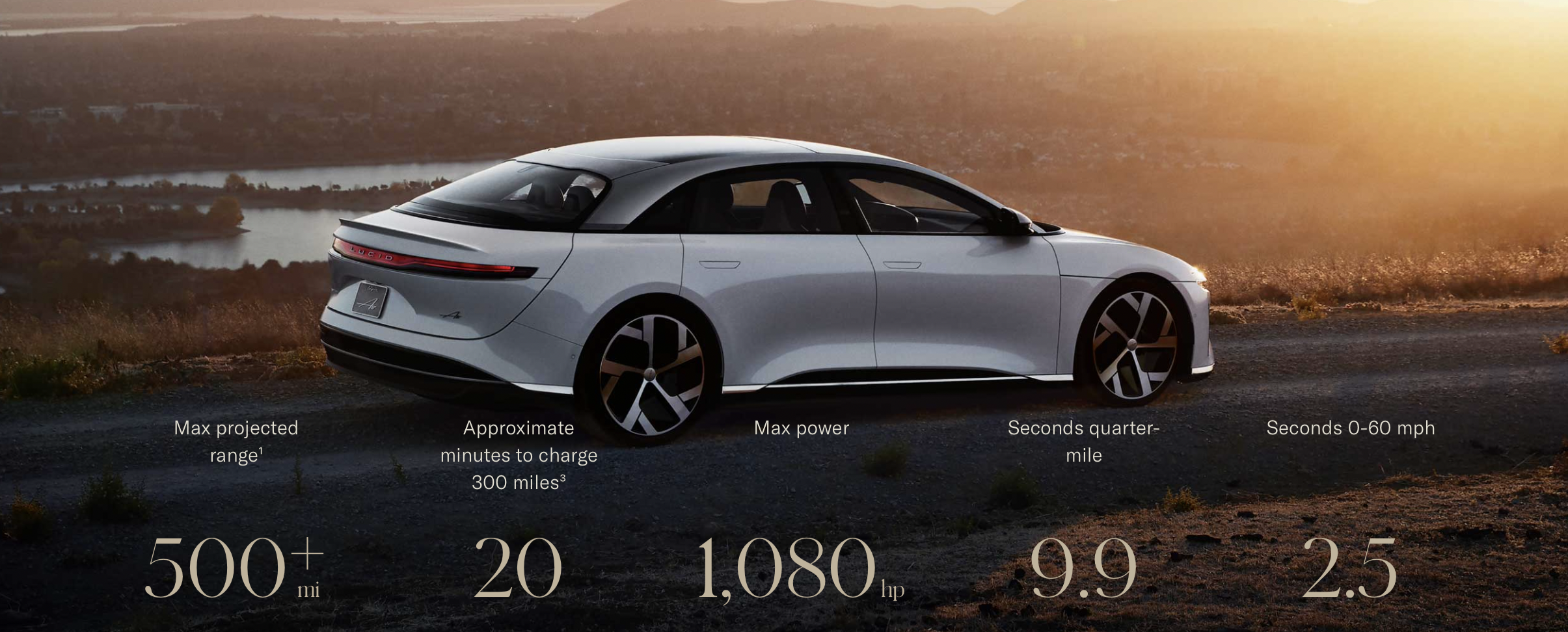 As a “Tesla killer”, Lucid Air has always been benchmarking against Model S. Looking back at last year, the current Model S and Lucid Air had a price drop match, and even Tesla aggressively improved the current Model S’s endurance in order to suppress Lucid Air in terms of endurance and price. Therefore, the redesigned Model S is even more focused on acceleration to make Lucid Air suffer. Both the 0-60 mph time and the quarter-mile time are beaten, only slightly falling behind in motor horsepower.
As a “Tesla killer”, Lucid Air has always been benchmarking against Model S. Looking back at last year, the current Model S and Lucid Air had a price drop match, and even Tesla aggressively improved the current Model S’s endurance in order to suppress Lucid Air in terms of endurance and price. Therefore, the redesigned Model S is even more focused on acceleration to make Lucid Air suffer. Both the 0-60 mph time and the quarter-mile time are beaten, only slightly falling behind in motor horsepower.
Even going to the Laguna Seca racetrack to set lap records is likely to beat the fastest four-door car lap record of 1:31.3 set by the Lucid Air Dream Edition prototype.
In fact, it is not appropriate to compare the ET7, as the fully equipped price is also in the price range of Model S starting at less than $800,000. And purely in terms of absolute performance, perhaps only the fixed-state battery with a range of 1,000 kilometers has lure. Of course, the advantage of the ET7 is NIO’s service.
The current price and configuration of the EQS have not been announced yet. Referring to the price of the Mercedes S-Class sedan, it should be basically the same as the Model S. In the dual-motor version, the horsepower of 600+ is only half of Tesla’s, with an actual 0-60 mph acceleration of 4.3 seconds. Of course, we actually have more reason to look forward to the AMG version of the EQS at a higher price. In this way, the price difference will highlight the performance-to-price ratio of the Model S even more.
Finally
In conclusion, I am not a Tesla fanboy. All analysis and examples are welcome to be discussed or corrected. The part of Tesla’s autonomous driving, which Tesla takes pride in, is not mentioned much in this article because I want to show everyone that Tesla’s products have many interesting features even without autonomous driving, some of which are worth learning and some of which must be criticized.
But you have to admit that Tesla’s control of electric vehicle product hardware and software, even the upstream and downstream voices, has become a unique capability of Tesla and these capabilities are constantly strengthening. The rest of the competitors either choose to break through the technology head-on or choose to seek a clever solution to achieve some sort of overtaking.
I am still looking forward to watching Geralt planting grape (dog head) in Niflgaard on the car multimedia system.
This article is a translation by ChatGPT of a Chinese report from 42HOW. If you have any questions about it, please email bd@42how.com.
